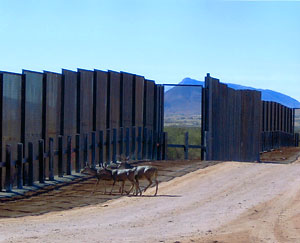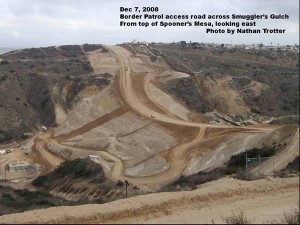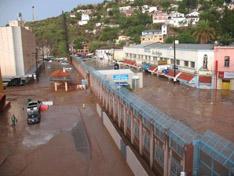
Mule deer blocked by the new border wall through the San Pedro Riparian National Conservation Area, Arizona. Photo: Sierra Club.
The American people may not yet realize it, but we approved—by way of our former president and Congress—the building of a Berlin Wall in North America. It’s the U.S.-Mexico border wall, rampaging for hundreds of miles through sensitive wildlife habitat. Unlike the German model, this wall does not stop humans; the best estimates (including those of INS) are that it only slows humans by two to five minutes. But the wall stops wildlife cold.
I learned about the wall’s effects last week when I visited Prescott College, where Sergio Avila-Villegas, a wildlife biologist with the Sky Island Alliance of southern Arizona and New Mexico, was the keynote speaker at our weekend colloquium.
A press release from the Sierra Club from April 1, 2009, says:
The border wall has destroyed precious areas and disrupted local communities across the borderlands region. In California, the double and triple layer border walls blind nocturnal animals with floodlighting, disrupting their ability to feed, migrate or mate. In Arizona, a steel wall fifteen feet high now cuts across the San Pedro Riparian National Conservation Area, a critical bird habitat. In Texas, where the wall now cuts through wildlife refuges along the Rio Grande, concrete border walls topped with metal prevent animal access to water and threaten endangered species, including the first ocelot kitten seen in Texas in more than a decade.
Ocelots? Yes, and jaguars too.
Jaguars? In this country? Yes, although once common, North American jaguars, the largest native cats, are on extremely rare here. But they are occasionally spotted in the border regions between Mexico and Arizona. Now the jaguar habitat is being bisected by the border wall, and it is likely that the few remaining animals are being stranded on one side or the other.

Border wall construction access road through formerly roadless Otay Mountain Wilderness Area, California. Photo: Roy Toft, ILCP, Lighthawk
The building of the border wall is wreaking environmental destruction akin to mountaintop removal. And the worst of it is—it’s all legal.
How can that be, you ask? Because in 2005 Congress passed the REAL ID Act, which included an obscure provision (Sec. 102) that allows the Secretary of Homeland Security (an appointed, not elected, official) to bypass existing laws in order to build roads and walls along the border.
Here is a list of the environmental and cultural protection laws that have been waived, according to the Sierra Club:
- National Environmental Policy Act
- Endangered Species Act
- Clean Water Act
- National Historic Preservation Act
- Migratory Bird Treaty Act
- Clean Air Act
- Archaeological Resources Protection Act
- Safe Drinking Water Act
- Noise Control Act
- Solid Waste Disposal Act
- Comprehensive Environmental Response, Compensation, and Liability Act
- Archaeological and Historic Preservation Act
- Antiquities Act
- Historic Sites, Buildings, and Antiquities Act

Smuggler’s Gulch filled in for access road, Dec. 7, 2008. Photo: Nathan Trotter
- Wild and Scenic Rivers Act
- Farmland Protection Policy Act
- Coastal Zone Management Act
- Wilderness Act
- Federal Land Policy and Management Act
- National Wildlife Refuge System Administration Act
- Fish and Wildlife Act of 1956
- Fish and Wildlife Coordination Act
- Administrative Procedure Act
- Otay Mountain Wilderness Act of 1999
- California Desert Protection Act
- National Park Service Organic Act
- National Park Service General Authorities Act
- National Parks and Recreation Act of 1978
- Arizona Desert Wilderness Act
- Rivers and Harbors Act of 1899
- Eagle Protection Act
- Native American Graves Protection and Repatriation Act

July 2008 flooding in Nogales, Sonora, and Nogales, Arizona. Photo: Sierra Club.
The suffering for wildlife is matched, of course, by the human suffering taking place along the U.S-Mexico border. We hear about the deaths of immigrants in the desert. We don’t hear about the flooding caused by stopping up rivers in order to build the border wall. In July 2008 flooding on the Mexican side of the wall reached seven feet high in Nogales, Sonora, wiping out homes and places of business.
The solution? HR 2076, The Border Security and Responsibility Act of 2009.
Arizona Congressman Raúl Grijalva has introduced this bill to prevent some of the unintended consequences of our inane immigration policy. Call your Congresspeople today and show your support for more humane and environmentally sensible immigration policies.
The following info comes from the Facebook page of the Sierra Club Borderlands Campaign, courtesy of Dan Millis, campaign coordinator. (Update: For info on what the Sierra Club is doing today to preserve borderlands, see the Sierra Club Borderlands page.)
|
———————————–—————- Border Wall Mileage Count = 630 (June 12) ———————————–—————- The issue-U.S. border policy has encroached on precious wildlands and habitat in many ways, such as reckless use of off-road vehicles, building roads and detention facilities in wild places, blinding nocturnal wildlife with stadium lighting, and building unnecessary improvised cement plants and other infrastructure to support their most destructive, expensive, ineffective and inhumane project – the border wall. The Sierra Club has taken a strong stance against policies that promote environmental degradation including those that provide for destructive border enforcement activities. MATERIALS DOWNLOADS AND LINKS: Wild Versus Wall border film STUDIES: Flesch et al., 2009. “Potential Effects of the United States-Mexico Border Fence on Wildlife,” Conservation Biology. Cornelius, Wayne, 2009. “Evaluating U.S. Immigration Control Policy, What Mexican Migrants Can Tell Us.” UC San Diego, April, 2009. (link no longer active) Border wall floods Organ Pipe Cactus National Monument, July 2008. |
Awesome resource, Priscilla. Thanks! I always thought the wall was stupid and useless, but seeing its effects on nature just adds to the boil in my head and heart. Thanks for bringing this to my attention.
Your blog post helps me understand the sinking feeling I had touching the rusty corrugated wall on the California border between Mexico and the U.S., as I was beginning the hike north on the Pacific Crest Trail to Canada. The border wall is just about the ugliest thing imaginable, and the dirt on the U.S. side is raked to reveal footprints. At night, illegals passed by us as we camped, and were arrested soon after being driven out of the mountains by a storm. This was all heartbreaking enough, but that animals are adversely affected–how sad.
Thanks for drawing my attention to this issue. I long ago thought the fence was a terrible idea, but media attention to it has died, and quite frankly I forgot all about it. Migration and habitat corridors are so important to the survival of species; perhaps there needs to be a new organization: “Wildlife Without Borders”!
Yes, I was as surprised as all of you to find that this boondoggle is going forward–at the cost to taxpayers of a cool $4.5 million PER MILE (according to the group Taxpayers for Common Sense). It will take publicizing this enormous problem and putting pressure on Congress to reverse such a harmful policy. Please, everyone, spread the word to your own circles.
I’m glad that used the Berlin Wall analogy. When this wasteful montrosity was first erected, I used to remind people that Ronald Reagan made brownie points with his conservative base by crying, “Mr Garbachev. Tear….down……this……wall!” Then George “Dubya” Bush, his heir, tried to court HIS conservative base by building one.
Dear, oh dear. Hopefully this is yet another folly that Mr Obama can clear up. Poor chap, he’s got his work cut out!
Folly indeed–good word for it, Andy. Publicizing is the first step to getting the policy changed. The president can only lead in the direction the people want to go, so let’s be sure the people know about this!
Egads! I never even thought about the environmental impact the border wall might have. Thank you so much for bringing this to light. Thank goodness my local representatives voted the right way!